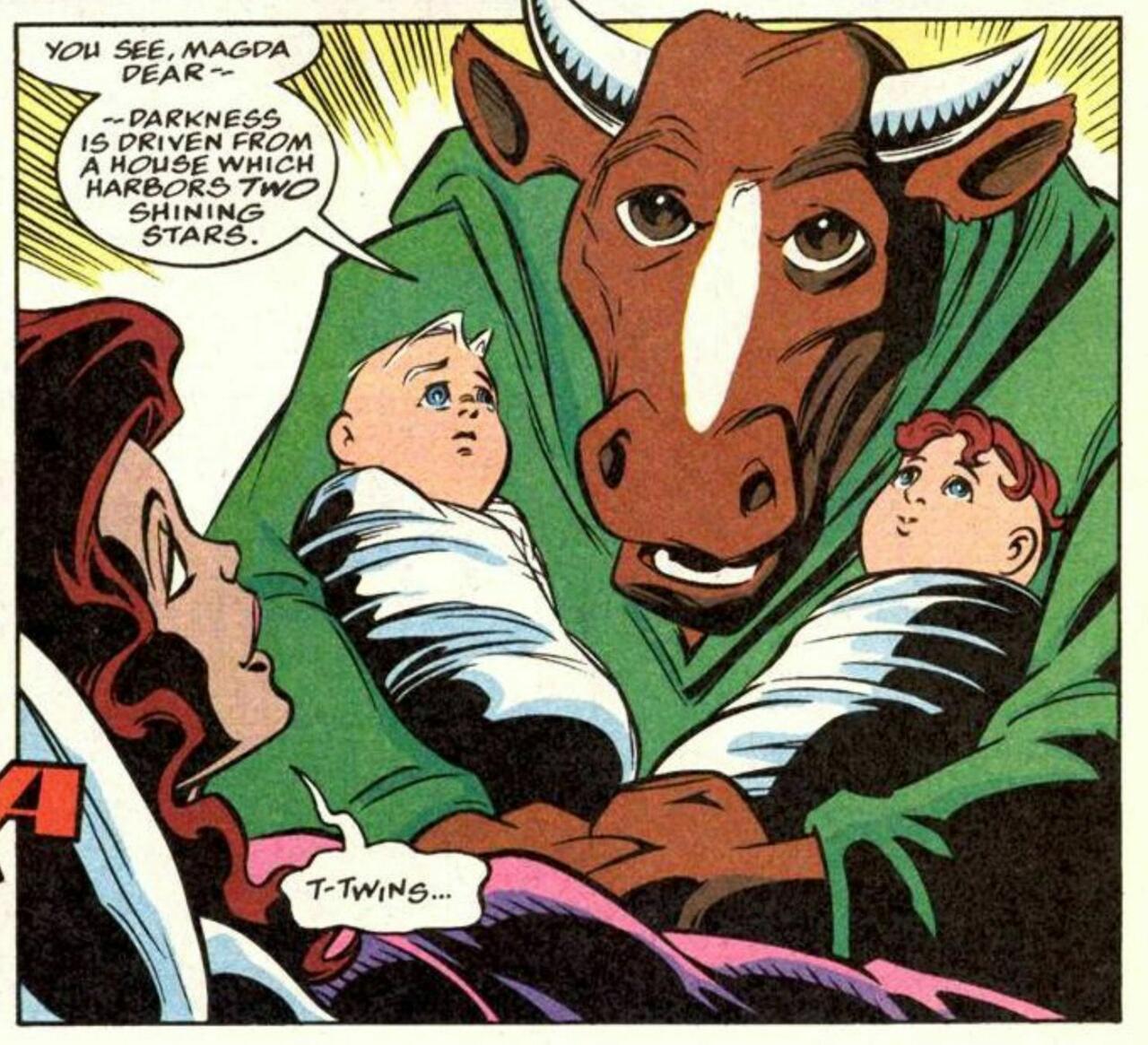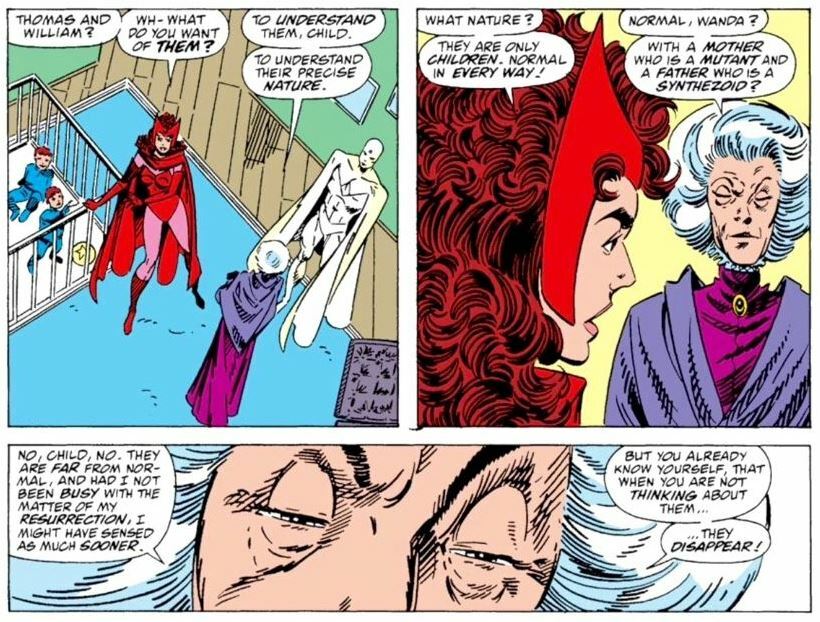WandaVision: Wanda Maximoff's Insane Comic History Explained
Wanda Maximoff, AKA Scarlet Witch, is headed to her own show on Disney+, but before you watch you might want to brush up on her completely bizarre comic book history.
Much like her on-again-off-again romantic interest, Vision, Wanda Maximoff AKA Scarlet Witch has been rocketed into the pop culture mainstream by her prominent role in the Marvel Cinematic Universe--and that spotlight is only going to get brighter now that she's making her way to her very own show. WandaVision is headed for Disney+ in 2021 and, with any luck, it will both help clear up some of the loose ends in Wanda's MCU story and establish her moving forward as she goes on to feature in more films, like Dr. Strange and the Multiverse of Madness.
On the big screen, Wanda's story has been relatively streamlined. She, like Vision, was introduced in Avengers: Age of Ultron as a Sarkovian refugee along with her brother, Pietro AKA Quicksilver, who had been subjected to human experimentation by HYDRA with the Mind Stone. It's not entirely clear how the experiments actually worked or why they gave the twins the powers they wound up with, but Wanda came out of the HYDRA facility with the ability to telekinetically move objects and manipulate people's minds. That last power was only featured once or twice, particularly in making heroes like Captain America fall into dream-like illusions--but it's still something worth keeping in mind.
Functionally, in the MCU, Wanda is a science experiment gone awry. She started out very much under HYDRA's thumb but eventually was freed from their control to join the Avengers, where she became a point of contention for her strange and difficult to control powers. The fact that no one knew exactly how strong or how in control she was wound up becoming one of the major inciting incidents for Captain America: Civil War and the creation of the Sokovia Accords.
Over in the comics, Wanda's history is considerably more complicated and strange, but full of themes and motifs you'll likely find very familiar as an MCU fan. Introduced in X-Men #4 back in 1964, Wanda and Pietro were first cast as members of Magneto's Brotherhood of Evil Mutants, though neither of them were completely bought-into Magneto's ideologies. But they didn't stay exclusive to X-Men titles, or villains, for very long. Experiments in publication and team lineups allowed writers like Stan Lee and Roy Thomas to shuffle both Wanda and Pietro into Avengers-adjacent teams in titles like Tales of Suspense, where the seeds of things like Wanda's eventual relationship with Vision were planted.
Things didn't start getting truly bizarre for Wanda until creative teams began trying to tackle her origin story. Around a decade or so after she first debuted, a story called The Yesterday Quest was published in Avengers #185, kicking off an arc meant to peel back the layers of Wanda and Pietro's history.
It went a little something like this: The twins had, for their entire lives, believed themselves to be the children of two D-list superheroes, Miss America and The Whizzer, but this never quite sat right with them and, soon, they both began experiencing hazy recollections of something that may or may not have been their true past. Eventually, Wanda was visited by a man named Modred the Mystic who took her down an "arcane path" to find answers, leading her to a place called Mount Wundagore, former home of the High Evolutionary.
Naturally, Modred tried to betray Wanda and was ultimately foiled by Pietro with the help of a strange humanoid cow person named Bova who related the twins' actual story. It turned out that Miss America and Whizzer were not, in fact, their real parents; they had been born to a woman named Magda, the wife of Magneto, who hid herself away at Mount Wundagore before she gave birth. When the twins were actually born, an Elder God named Chthon (a demon and the first practitioner of black magic in the Marvel universe) gave Wanda her magical abilities through a sort of arcane mutation he was able to instill in her as an infant, hoping that he'd be able to use her as a vessel when she grew up.

Don't worry too much about that part yet. The important takeaway here is that Magda died not long after the children were born, leaving Bova to attend them both through their infancies. Later, a pregnant Miss America found herself at Mount Wundagore, carrying The Whizzer's child, but despite Bova's help, both she and the baby died during childbirth. However, Bova saw this as an opportunity and told The Whizzer that the twins were actually his, establishing that part of the lie both Wanda and Pietro believed for most of their lives.
If all of this sounds wildly convoluted, that's because it is--but it's actually pretty typical for superhero origin stories in the '60s and '70s. This was when a lot of shared continuities for major publishers were finally being properly solidified and there was tremendous pressure on editorial teams to justify and fold in any and all disparate parts of a hero's publication history without retconning or hand waving anything away--even the parts that came well before anyone was trying to maintain consistent character details. The end result is--well, a lot of things like this, where creative teams opted to invent all sorts of incredibly convoluted ways to make sure fans who had been following Wanda from her debut didn't feel like the stories they read a decade ago no longer counted, even when her past was being completely overhauled.
Anyway, after the first part of the lie--that the twins' parents had been Miss America and The Whizzer--was in place, The Whizzer actually peaced out from Mount Wundagore rather than raise them. So the High Evolutionary and Bova were left to go with a plan B, leaving the kids in the care of a Romani couple named Django and Marya Maximoff--hence their inexplicable last name. Both Django and Marya were eventually taken out of the picture, leaving the twins orphaned and deeply traumatized to the point that they "forgot" about most everything in their past. Later, they were found by Magneto, who took them in as part of the Brotherhood without knowing he was their father, bringing us back to square one and their first appearance.
If you can believe it, Wanda's story actually doesn't get much cleaner or easier to understand, even after tying her origin up into a neat little bow. There was also the problem of her powers, which no one could really seem to figure out--she'd been first introduced as a mutant, but her new past added the layer of arcane influence into the mix. And even before that, the "Witch" part of her codename was taken very literally, making her abilities work like literal spells and curses rather than telekinesis. For a time, she was even tutored by a witch named Agatha Harkness who taught her to better control her "magic." Also the demon who gave Wanda her powers as a child, Chthon, did eventually come calling and eventually possesses her--you know how these things can happen. Some time later, her powers evolved yet again after a battle with the villain Morgan Le Fay left Wanda able to channel "chaos magic," making her even more powerful.
Oh, and also she and Vision were married for a while and Wanda was able to use her powers to conceive and give birth to two children, who would eventually be revealed to be powerful heroes (sort of--there's some reincarnation involved here) in their own right and join teams like the Young Avengers. But they're a whole other can of worms, so don't worry too much about them--just know they exist (sometimes), and you might see hints of both of them in the upcoming TV show.

Later still, Wanda's powers evolved again as part of what is arguably her most famous story arc, House of M. After being merged with a cosmic entity in hopes of restoring parts of her memory (she suffers amnesia very, very frequently--probably more frequently than most superheroes, and losing memories is a pretty common superhero trope) she completely lost her grip on herself and her abilities, which now included the absurdly powerful "reality warping" bonus skill. This is where the frequently memed "no more mutants" panel comes from--an unhinged Wanda uses her newfound gift to speak her thoughts into existence, in this case, the near-complete extermination (some mutants were just depowered, but many, with mutations that were life-sustaining parts of their biology, died) of the mutant population in an event called M-Day.
They got better eventually, so don't panic. The net result, however, was a world that really, really did not trust poor Wanda (understandably) and even more amnesia for Wanda herself that lasted for a while--about a year or so of real-time publication.

M-Day was formally reversed by Wanda saying "no more Phoenix" to destroy the Phoenix Force (for a while) and restore the mutations to the remaining mutant population. This did help bolster Wanda's public image, but the fear and anxiety many felt about her both within and outside of the mutant community didn't disappear overnight and went on to become a prominent theme in her stories, well into very recent years.
In fact, her origin story was revisited yet again in 2016, adding a new biological mother, Natalya Maximoff (the sister of Django Maximoff--remember him?) and a legacy component to the Scarlet Witch name. More recently still, in the Dawn of X X-Men relaunch, it was confirmed once and for all that Wanda is, in fact, not a mutant, despite what her early stories insinuated. She's just a human who can use magic, and mutant-kind now refers to her as "the Great Pretender" for the decades-long confusion.
So where does that leave us? Well--it will probably not surprise you to hear that the answer is a little tricky. Wanda's publication history has stretched on for almost six decades, and in that time, the character has defied strict definition. Even her powers, which started as "hexes" and then gradually became cosmic-level reality warping, have never been easy to pin down or explain.
But for as esoteric as Wanda is, and probably always will be, she does have some pretty easy to spot throughlines. Thematically, Wanda's existence in the Marvel Universe hinges on both change and evolution--she's used to explore the fear of things far outside our control and the complex balance of power and responsibility. If you think Peter Parker has it bad as a guy who can sling webs and do cool acrobatics, imagine being a person who can speak any idea she has into existence--even at the cost of hundreds of thousands of lives.
As for WandaVision, we're very likely to start seeing some of these themes come into even starker relief. They were touched upon back in Captain America: Civil War, and the real extent of her on-screen abilities was hinted at in Avengers: Infinity War when she was able to hold off, and destroy, the blast from not one but two Infinity Gems--if only temporarily. Based on the trailer, it seems likely that we're going to start seeing the real cost of wielding that sort of power--which can be a very dangerous thing when you mix it with grief and loss and alienation. Layer that with Vision's ongoing existential crisis and--well, it's probably going to get really, really weird.
WandaVision hits Disney+ January 15, 2021.
Got a news tip or want to contact us directly? Email news@gamespot.com
Join the conversation